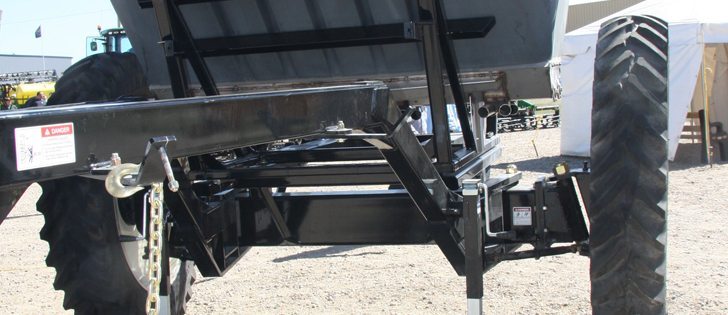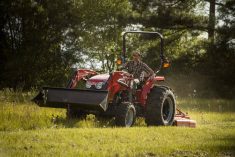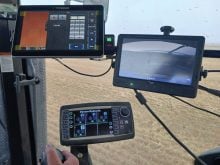FARGO, N.D. — A self-steering fertilizer cart has advantages for row croppers or anyone who wants to keep their tires between the rows.
“The Montag Auto Steer system lets the cart follow very well,” says North Dakota farmer Carson Klosterman, a dealer for the Montag cart.
“It follows your planter or strip tiller or you can use it for side dressing. It really shines in situations where it’s crucial the tires stay between the rows.”
He said the Montag has a unique steering system with two independent goosenecks that hook to the back of the toolbar’s frame. The goosenecks run back along the length of each side of the cart and connect to tie rods that control the steering angle of the hub on each side.
Read Also

Growing garlic by the thousands in Manitoba
Grower holds a planting party day every fall as a crowd gathers to help put 28,000 plants, and sometimes more, into theground
As the unit turns a corner, the two goosenecks have a push/pull effect on the tie rods. One side of the frame becomes longer while the other side becomes shorter.
For example, in a left turn the left gooseneck pushes back. The tie rod pushes the hub so the inside tire steers into a tighter turning radius.
On the other side of the cart, the gooseneck pulls the tie rod forward so the outside hub and tire run a larger radius.
Together, the two goosenecks create the Ackerman angles necessary for a smooth turn with a minimum of sideways soil scrubbing.
The kingpins are about the same as what can be found on the front axle of a semi tractor front axle.
The extreme angle of the kingpin is needed to help the tires roll through a turn with a minimum of side force.
“The cart can be liquid or granular. You switch between the two tanks very quickly,” said Klosterman.
He said the tanks are considered to be skids. Loosen four to eight bolts to switch tanks, depending on the model. Remove one skid, slide the other on and tighten the bolts.
The liquid tanks have a 15 degree cone bottom. The granular tank and lid are polyethylene. The metering system is made of 300 series food grade stainless steel for extra resistance to chemicals.
The tank also has an air release to vent excess air from the hoses before injecting fertilizer into the soil.
The Twin Bin option consists of two granular tanks, each with its own metering system. It allows a producer to put down up to 600 pounds per acre total product volume.
If teamed up with ammonia, the two Montag tanks can run phosphorus and potassium so that one pass puts down all fertilizer.
The smaller tanks have a hydraulic requirement of 15 gallons per minute at 2000 pounds per sq. inch. The larger tanks have a requirement of 19 g.p.m. at 2500 p.s.i.
Montag Auto Steer carts start with a six ton unit capable of carrying 1,200 gallons of liquid or six tons of granular. Prices for the eight-row, six ton cart start at $36,000.
The 24-row nine ton cart carries 1,700 gallons liquid or nine tons granular, mounted on rubber tracks. It sells for $65,000.
The 24-row 12-ton Lift Assist has bigger spindles. It carries 1,700 gallons liquid or 12 tons granular. The Lift Assist transfers six tons of weight from the toolbar to the three point hitch on the tractor. It lists for $56,000.
All prices are quoted with a granular box. The 1,200 gallon liquid tank is a $3,200 option.
The 1,700 gallon liquid tank in a $3,700 option.
For more information, contact Carson Klosterman at 701-899-1439 or visit www.dawnstriptill.com.


















